The amenity of the place has influenced the most popular etymology of the name, coming from the sirens, who lived in the sea area in front of the promontory of Sorrento, from where they easily attracted more travellers.
However, there is a more probable explanation: the derivation of Surrenton, a word already used by Strabo, from the Greek verb “flow” referring to the abundance of water and rivers of the area. In a region already populated in the Neolithic, Sorrento has Greek origins and has been conquered by Liparus, son of King Auson, who wanted to be buried there after having governed it for a long time. Submitted to the dominion of Syracuse (5th century b.C), the small city passed hands to the Samnite first and then to the Romans. During the Imperial era, entitled as a city hall, it started to be appreciated as a privileged holiday place, favoured by the mild climate and by the exceptional fertility of the soil. This is how a real expansion of villas started, appearing along the coast especially during the age of Caesar and Augustus.
In honor of the Patron
In the old town, it still keeps visible his roman structure, among hinges, decumans and ancient remains such as pillars of the temples reused in the construction of churches like the patron saint one, Sant’Antonino (it is the transformation of a fourteenth century oratory) with a side portal of the 11th century. But in the 9th century, a worship place dedicated to the saint already existed. It was given to the Theatine priests and was rebuilt with the actual existing forms. It has a Latin cross plan, three naves and a crypt where the silver statue of the saint is kept, as well as other “ex-voto” of marine inspiration. The paintings of Giacomo del Po describe the plague of 1656 and the siege of 1648.
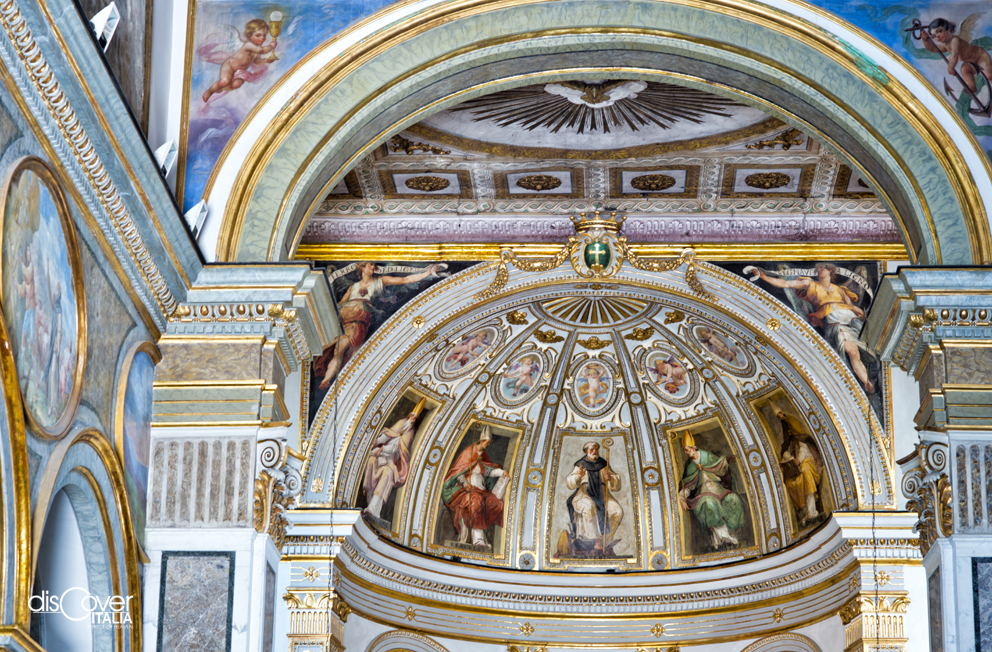
Of great suggestion is also the Chiostro di San Francesco (Cloister of St. Francesco) annexed to the church with the same name. It was built in 1500 and then entirely redone after the earthquake of 1688, finally transformed with the actual white marble façade in 1926, to coincide with the seventh anniversary of Saint Francis’ death. The cloister, really beautiful, has a double row of the late fourteenth century: on the capitals there is the emblem of the families Sersale and Nobilione. It hosts cultural events of great importance, in summer.
Ten centuries of art and history inside the Cathedral
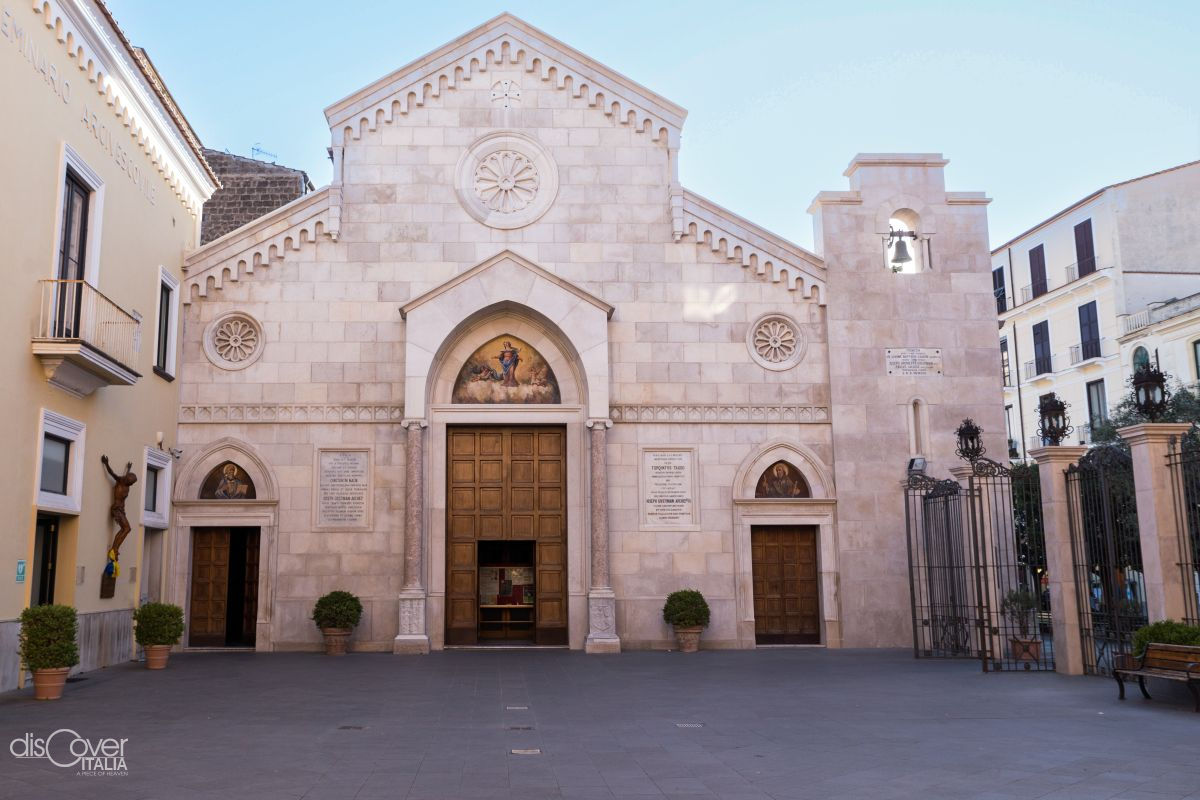
In origine, prima dell’XI secolo, la chiesa madre era collocata vicino al cimitero, fuori dalle mura cittadine. All’interno delle quali, invece, fu traslata nel corso del X secolo, temporaneamente allocata nella chiesa dei Santi Felice e Bacolo. poi dedicata ai Santi Severo e Renato. Nel frattempo, nel sito di un antico tempio greco, si dava inizio alla fabbrica della nuova cattedrale, che si concluse intorno all’XI secolo. Più certa è la data della sua consacrazione all’Assunta e ai Santi Filippo e Giacomo il Minore, avvenuta il 16 marzo 1113 da parte del cardinale Riccardo de Albano.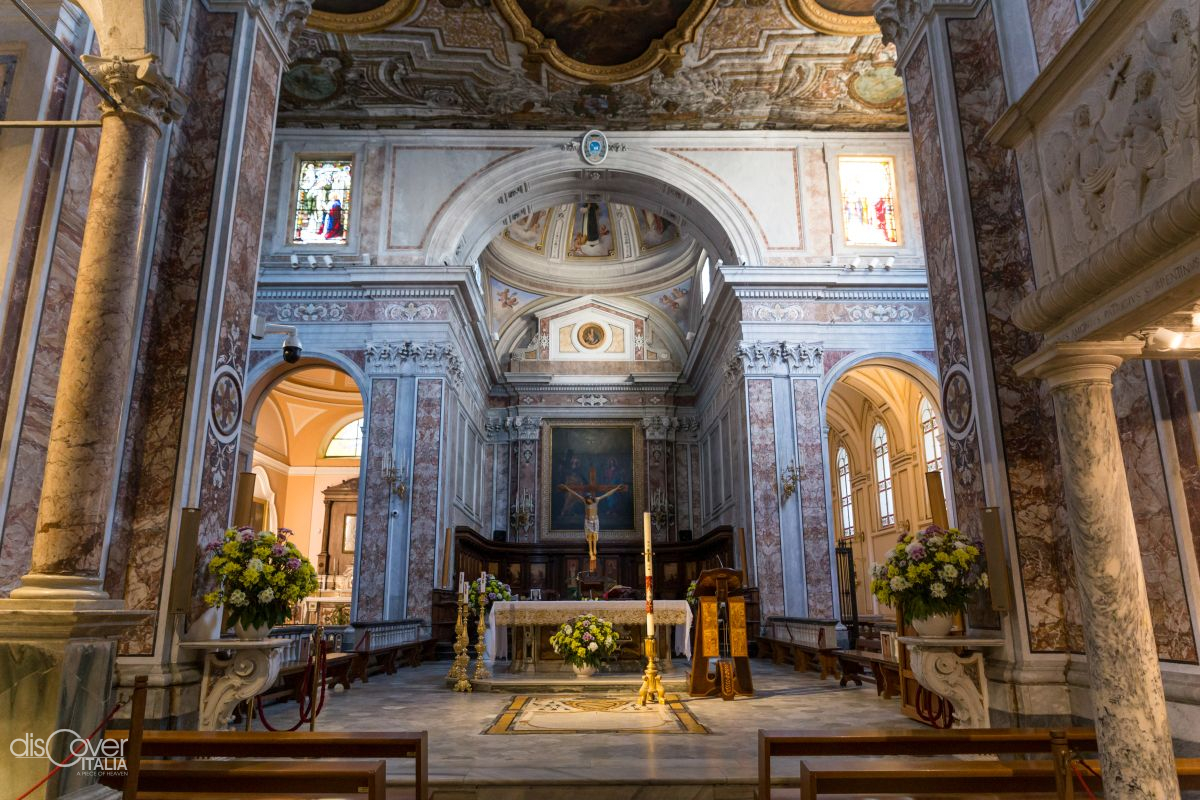
Era solo l’inizio di una lunga serie di trasformazioni. Un primo ampliamento fu realizzato nel 1450, un altro seguì nel1505. Solo tre anni più tardi, la Cattedrale subì danni ingentissimi in occasione del memorabile attacco dei Turchi che mise Sorrento a ferro e fuoco. Nel Settecento la chiesa fu riedificata e adeguata al gusto barocco ormai imperante.
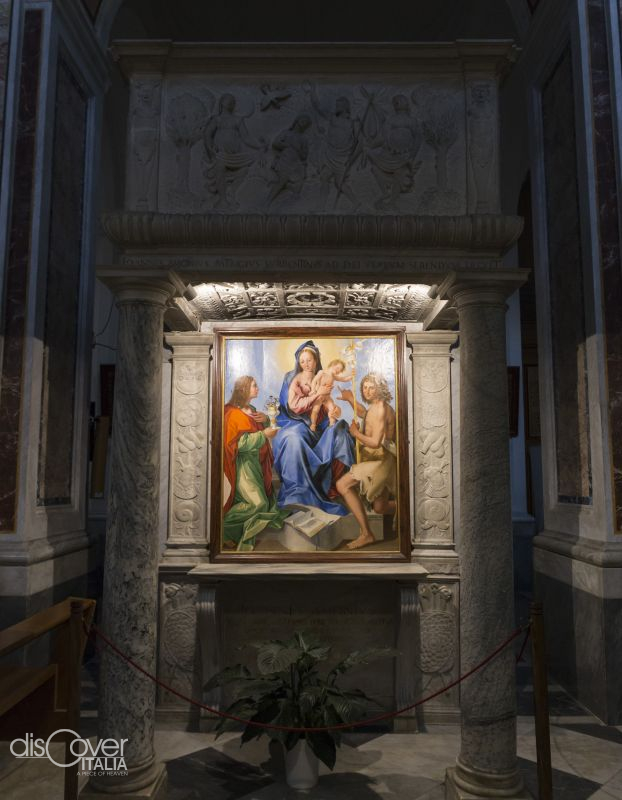
A croce latina, divisa in tre navate, separate da quattordici pilastri, la chiesa presenta il soffitto centrale decorato con dipinti su tela del 1711 di Francesco Francareccio e di Oronzo e Nicola Malinconico, raffiguranti i primi martiri sorrentini del II secolo e i compatroni della Diocesi. I dipinti sul soffitto del presbiterio, invece, sono di Giacomo del Po, dedicati all’Assunta e ai Santi titolari della chiesa. A loro è ispirata anche la pala seicentesca sulla parete di fondo del presbiterio, mentre il coro ligneo finemente intarsiato è del 1936. Dei primi del Nocevento sono gli affreschi di Pietro Barone e Augusto Moriani sugli otto spicchi della cupola. La cattedra episcopale è formata da pezzi di spoglio da templi pagani e da parti cinquecentesche. Il pulpito presenta un bassorilievo del Battesimo di Gesù con una tavola di Silvestro Buono del 1573.
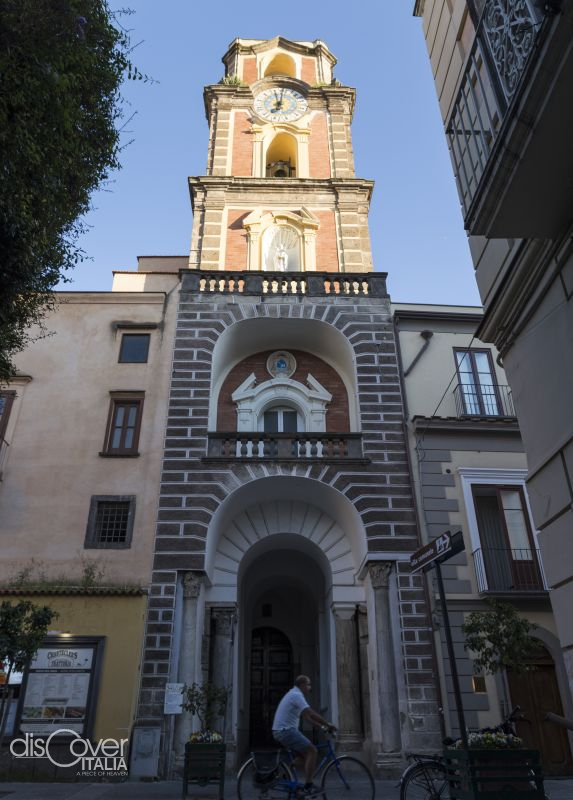
Altre opere di grande pregio sono il Cristo in croce del XV secolo su un trono di legno scolpito del XVII secolo nel cappellone del Santissimo Sacramento e gli stucchi seicenteschi nella Cappella della Riconciliazione, che conserva un raro pavimento di maiolica.
La cappella a sinistra del transetto accoglie una statua lignea settecentesca di Sant’Antonino. L’altare seicentesco e di marmi policromi.
Nella sagrestia sono custoditi preziosi antifonari in pergamena del XV secolo, paramenti e paliotti d’altare di varie epoche. C’è anche una Trasfigurazione del Signore con ritratto del committente, l’arcidiacono Giovanni Ammone del 1573, donatore del pulpito.
Nell’ultima cappella nella navata di sinistra, è esposto un pregevole presepe napoletano del 1700.
Di fianco alla cattedrale sorgono il palazzo vescovile del Cinquecento e il caratteristico campanile coevo, che reca alla base dei reperti marmorei romani e un’epigrafe longobarda, mentre furono aggiunti nel Settecento i due piani superiori con l’orologio di maiolica.
A look on the history
In order to deepen the past of Sorrento, you have to visit the Museo Correale di Terranova, a harmonious edifice of the eighteenth century, which hosts the art collections given to Alfredo and Pompeo Correale, counts of Terranova, last descendants of an ancient Sorrentine family.
It was inaugurated on the 10th of May 1924 and, on over three floors, it presents archaeological artworks, paintings and decorative arts. The founders’ hall, with the small private chapel, hosts the Collection of the Sorrentine inlays of the nineteenth century. In the Hall of Mirrors, there are the portraits of Correale’s ancestors, ladies and knights with splendid clothes which recall the splendour of the Age of Enlightenment. Then, there are also the Neapolitan still lives of the 17th century and the landscape paintings; then the collection of Neapolitan nativity figures and European porcelain of the 18th century. Finally, you can admire the garden full of flowers and rare plants: through an alley of oranges and after an underpass, you can get to the Belvedere overhanging the sea. Not to be missed.
 In order to know the city more in depth, you have to move through different levels, classic in the Coast: the one on the sea and the internal one, elevated. From the picturesque hamlet of fishermen, animated with bars, small shops and restaurants of Marina Grande with its ancient Greek Door (until the 15th century it was probably the only way from se routes) to the port of Marina Piccola, with the Church of Santa Maria del Soccorso which appears in every photograph. Then we revisit the historic centres.
In order to know the city more in depth, you have to move through different levels, classic in the Coast: the one on the sea and the internal one, elevated. From the picturesque hamlet of fishermen, animated with bars, small shops and restaurants of Marina Grande with its ancient Greek Door (until the 15th century it was probably the only way from se routes) to the port of Marina Piccola, with the Church of Santa Maria del Soccorso which appears in every photograph. Then we revisit the historic centres.
Through the streets of the historic center
We have to remember that Sorrento has a particular topography conditioned by the position of the residential area on a block of steep tuff. For a long time, the sea and the ravines delimited the ancient town. We have an example when we look out from Piazza Tasso, on Vallone dei Mulini, a canyon covered with a scrub vegetation, which delimits a side of the town from where you can see the remains of old windmills which it takes its name from (mulini). As we said, the town as crossed by the decumanus, which still keep their peculiarities: the highest and oldest one of Via Pietà and the other of Via San Cesareo. The first one, in fact, corresponds to the superior roman decumanus, which then –in 1861, was modified in Corso Italia, when the urban structure was modernised. Then, in Via Pietà, there is a succession of noble houses of the eighteenth century such as Palazzo Correale with a “crown” gate and inhabited by the family
Until 1597; and Palazzo Veniero, which is a significant proof of late byzantine and Arabic style of the 13th century. In Via San Cesareo, there are the remains of the Sedile Deminova: a loggia of the 15th century with a majolica dome, which protects one of the two “seats” (the other one is the Sedile di Porta), in which the Sorrentine nobility was divided. There, the fates of the town were decided. The seats were edifices of quadrangular shape with large side entrances and this is the only proof left in Campania.
Queen Giovanna's baths
In the quick tour of Sorrento, we have to include an important walk at Capo di Sorrento. On its extreme point, soon after the pool-grotto of the Queen Joan’s Baths (Bagni della Regina Giovanna), there are the remains of the Villa of Pollio Felice, which Papinius Statius was writing about.
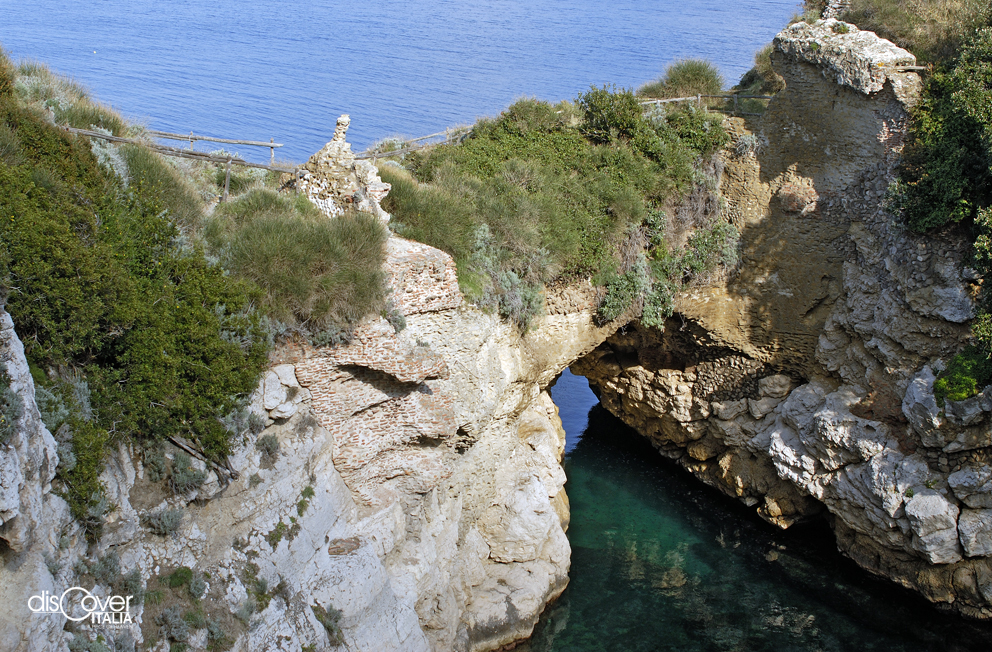
It was divided in domus and seaside villa, it has many rooms, terraces, landing places and cisterns. The main body was developped on the rocks of the lido of Carcarella. A villa with an inventive construction, almost above the water, exposed to the South-West with a marvellous panorama. The nymphaeum of two rooms with segments of opus reticulatum on the walls is still visible in the grotto of Queen Joan (also spelled Joanna). It is a unique and legendary place, a kind of natural triangular-shaped swimming pool, which you can access from the ground through steep stairs, which from the top go down to the water, whereas it is possible to access from the sea with a rowboat. In the centre, the rock keeps other roman ruins, which connect the whole structure to the Villa of Pollio. According to researchers, the pool was not used as a seaside place but as a destination for prized fish farming.
Regarding the name of Queen Joanna, the tale tells about this woman who, after every night of love, was throwing into the gorge of the sea cave her lovers. Awe do not have information regarding the real identity of the Queen. Maybe they were two coinciding personalities in the time of which stories are told in Naples.


Comments powered by CComment